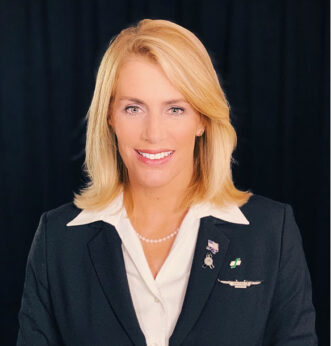
WASHINGTON —After a long delay the GOP Trump regime’s Transportation Department imposed, the Federal Aviation Administration has approved longer rest hours, 10, after 14-hour stretches in the air, for the nation’s flight attendants.
The rest period rises from its current nine hours, between supposed maximum work periods of 14 hours straight, and the rest “can’t be reduced under any circumstances,” the rule announced by Biden administration Transportation Secretary Pete Buttigieg on Nov. 2 says.

“Fatigue is real. We need our 10 hours yesterday,” said Association of Flight Attendants-CWA President Sara Nelson, a veteran United Airlines flight attendant. Her union has led the long fight for more rest between long flight times.
But the rule won’t kick in until after FAA takes public comments, due by Jan. 3, then reviews and responds via the Federal Register.
Flight attendant unions, led by AFA-CWA, joined by the Association of Professional Flight Attendants (APFA), the Machinists, the Teamsters’ Airline Division, the AFL-CIO Transportation Trades Department, and the Transport Workers, have lobbied for years for the longer and mandated rest periods to reduce the strain of their on-and-off schedules—schedules often disrupted by bad weather and other factors.
The pilots already have the 10 hours’ rest and have had that for years.
“Buttigieg put our 10 hours back on track, and after internal review” with White House officials, “where our union met to press the urgency and facts about implementation at some airlines, the agency sent their review back to FAA over a month before the deadline,” AFA-CWA reported (their emphasis).
“The minute it hit FAA Administrator Steve Dickson’s desk last night he signed the order for a notice of our rule on rest. The rulemaking process now requires a comment period for 60 days, then the FAA will move to implement the final rule,” AFA-CWA said.
In 2018, flight attendant unions convinced Congress, in the law renewing FAA’s authority, to order the agency to immediately create and publish a rule mandating longer rest periods. But APFA, which represents American’s attendants, pointed out Trump’s FAA stalled. AFA said Trump’s FAA “meant to kill” the 10-hours-rest mandate.
“Congress intended it to be self-enacting or, in other words, to immediately implement what appeared to be the clear and simple rule,” APFA Government Affairs Director Julie Frederick told her union’s members in September 2019. “The DOT/FAA ignored the wishes of Congress and embarked on a lengthy and, in our opinion, unnecessary rulemaking process. They determined it was necessary to have an advance notice of rulemaking that requires a cost-benefit analysis, which adds many months to actual implementation.”
Buttigieg’s FAA put an end to that delay, though the airlines’ lobby, Airlines For America, resisted all the way through, according to the agency’s official notice.
“Flight attendant fatigue is a serious issue that can affect” flight attendants’ “health and safety and also that of the traveling public. The extra hour of rest is vital and long-overdue,” Machinists President Bob Martinez said in a statement.
Under the current rules, one Southwest Airlines plane years ago flew from Denver to Texas to Miami and then—after a half-an-hour break—took off again for Fort Lauderdale and Baltimore. The same flight crew was aboard all the way.
But when the plane got to Baltimore, fog had socked in all area airports from Richmond, Va., to Philadelphia and pilots couldn’t land it. The plane circled for at least three hours, had to divert to Norfolk, Va., to refuel, and finally made it to Baltimore when the fog lifted after 2 am. The scheduled landing had been at 9 pm.
Those attendants, who were in the air at least 18 hours—with only half-hour breaks for cleaning in Texas and in Miami and a short boarding break in Fort Lauderdale—were dead on their feet.
In its Nov. 2 notice of the final rule, the agency said AFA, the Transport Workers, the Professional Flight Attendants, the Teamsters, the AFL-CIO Transportation Trades Department, the Machinists, and the Airline Pilots all backed the 10-hour rest period for the flight attendants. So did a scientific association of sleep specialists. Some individual comments advocated even longer rest.
All the advocates said “flight attendants’ performance of their duties”—a long and exhausting list in the Federal Register—”is fatigue-inducing and that they would benefit from increased rest. These commenters also stated the increased rest would not always result in increased costs.”
Fighting a rearguard action against giving attendants more rest, the airlines’ lobby said the rules “should be limited to implementing only what” the 2018 law required and contended “the FAA should incorporate cost mitigation measures.” The lobby wanted to base the rest periods on “risk mitigation” and not by hours in the air.
AFA and the Teamsters retorted that “multiple airlines already included the additional rest that would result from the rule change” in the carriers’ contracts with the unions. Those “airlines implemented the additional rest quickly and without incurring additional costs,” they added. The airlines’ lobby’s “argument the increased rest is too costly and difficult to implement is without merit.”










